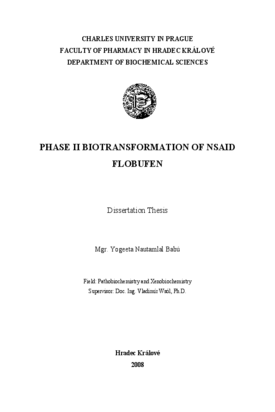Phase II biotransformation of NSAID flobufen
Druhá fáze biotransformace flobufenu
dissertation thesis (DEFENDED)

View/
Permanent link
http://hdl.handle.net/20.500.11956/16316Identifiers
Study Information System: 60462
CU Caralogue: 990010120300106986
Collections
- Kvalifikační práce [6957]
Author
Advisor
Referee
Nobilis, Milan
Kuchař, Miroslav
Faculty / Institute
Faculty of Pharmacy in Hradec Králové
Discipline
Pathobiochemistry and Xenobiochemistry
Department
Department of Biochemical Sciences
Date of defense
19. 6. 2008
Publisher
Univerzita Karlova, Farmaceutická fakulta v Hradci KrálovéLanguage
English
Grade
Pass
Xenobiotika jsou chemické sloučeniny tělu cizí, které se obvykle tvoří syntetickými nebo abiotickými procesy. Syntetická xenobiotika mají často obrovský význam pro lidskou společnost a představují většinu chemických sloučenin z tak významných skupin, jako jsou petrochemikálie, pesticidy, plasty a léky, u kterých se obvykle ve vztahu ke xenobiotikům používá termín léčivo. Biotransformace je hlavním mechanismem eliminace léčiv, protože ta se biotransformaci podrobí ihned po vstupu do organismu. Biotransformace, která téměř vždy poskytuje metabolity polárnější, než je výchozí látka, obvykle ukončuje farmakologický účinek parentního léčiva a prostřednictvím exkrece zvyšuje odstraňování léčiva z těla. Nicméně může mít i další důsledky včetně podobného nebo odlišného farmakologického účinku nebo toxikologického působení. Je mnoho odlišných drah, kterými může být léčivo biotransformováno, a ty zahrnují mimo jiné oxidační, redukční, hydrolytické a konjugační reakce. Je důležité těmto drahám porozumět, protože cesta metabolismu léčiva může určovat jeho konečný farmakologický nebo toxikologický účinek. Biotransformace léčiv se rozděluje do dvou fází: Fáze I neboli přípravné reakce a Fáze II čili konjugační reakce. Kromě fyzikálně-chemických činitelů ovlivňujících metabolismus xenobiotik, hrají důležitou úlohu v...
Xenobiotic chemicals are chemicals foreign to life that are usually derived synthetically or from an abiotic process. The synthetic xenobiotic chemicals are often of enormous value to human society and are usually the majority of the chemicals in such important groups of substances as petrochemicals, pesticides, plastics and pharmaceuticals, where the term drug is usually applied when referring to xenobiotics. Biotransformation is a major mechanism for drug elimination, as they undergo biotransformation after they enter the body. Biotransformation, which almost always produces metabolites that are more polar than the parent compound, usually terminates the pharmacologic action of the parent drug and, via excretion, increases removal of the drug from the body. However, other consequences are possible, including similar or different pharmacologic activity, or toxicological activity. The routes by which drugs may be biotransformed are many and varied and include oxidation, reduction, hydrolysis and conjugation reactions, among others. It is important that these pathways are understood, as the route of metabolism of a drug can determine its ultimate pharmacological or toxicological activity. Drug biotransformation is divided into two phases: Phase I, or functionalisation reactions and Phase II, or conjugative...
